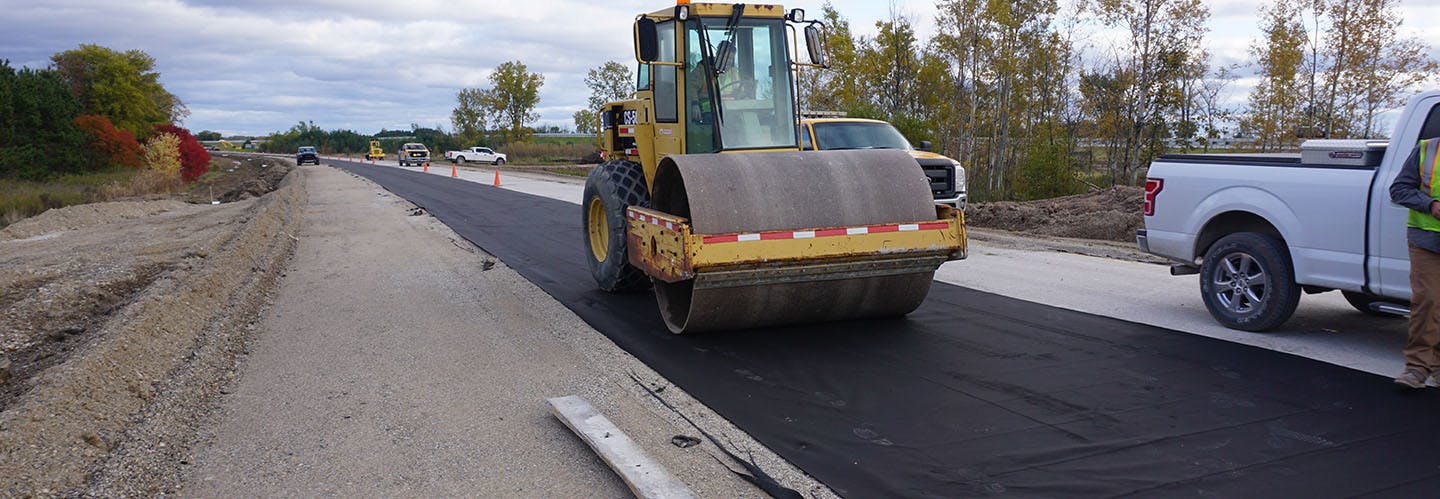Nonwoven Geotextiles Offer an Opportunity to Build Back Better
Posted on 4.27.2021 by Mark Marienfeld, P.E.
Over 40% of America’s roadways are in poor or mediocre condition according to the American Society of Civil Engineers. These deteriorating roadways cost the average motorist around $1,000 per year in vehicle repairs and wasted fuel. The U.S. roadway system has been critically underfunded for years, leaving a backlog of around $786 billion in road and bridge capital projects. Recently, President Biden announced a $2 trillion infrastructure package with provisions for roads & bridges, railways, and improved infrastructure resilience. Additionally, the White Houses’ Fact sheet on the American Jobs plan says it “will modernize 20,000 miles of highways, roads, and main streets, not only fixing them first but fixing them right, with safety, resilience, and all users in mind.”
It’s encouraging that our country’s leadership recognizes that innovation is just as crucial for roads, bridges, and railways as it is for the cars and trains that drive on them. Geotextiles offer a major opportunity to build better-performing roads and save money. These innovative technologies preserve and sustain road foundations, frequently doubling pavement life and allowing for faster, less expensive surficial repairs necessary for maintenance and rehabilitation.
There are many ways that geotextiles can support roadways. This article looks at how transportation agencies can reduce road downtime and dramatically lower future road maintenance costs by utilizing a nonwoven geotextile in roadway designs. Most importantly, this innovative technology won’t increase the cost to build lane miles.
The most common cause of premature pavement deterioration is loss of support from the foundation layers. Basic road design includes one or more layers of unbound aggregate to support the pavement. The thickness of the pavement and the support layers must spread the traffic load wide enough to avoid a bearing capacity failure of the subgrade soil Traffic loading and the presence of moisture creates upward migration of the subgrade soil into the aggregate, weakening the base support layer. Base aggregate contamination can cause drainage and moisture issues, leading to freeze/thaw damage and potholes.
Once support is diminished, pavement thickness must be increased to regain the support needed for traffic loading. Commonly, this means that additional pavement is overlaid on the failing pavement. This practice costs a significant amount to taxpayers and is not a permanent solution. When pavements become too thick or the profile is too high, the road must be totally reconstructed to rebuild the foundation support layers that were lost to contamination.
Now let us look at this same roadway design with the inclusion of a nonwoven geotextile as a separation layer between the subgrade soil and the unbound aggregate. This Permanent Road Foundation (PRF) prevents base contamination from subgrade soil, preserves the original thickness and strength of the aggregate support layer, and allows the use of a free-draining aggregate. Per AASHTO design, a free-draining aggregate provides twice the structural contribution per inch thickness compared to a tight, poorly draining aggregate.
In addition to separation, a nonwoven geotextile will enhance the structural performance of the aggregate layer and the subgrade. Extensive research has proven that the inclusion of a nonwoven geotextile for separation/stabilization increases the effective strength and bearing capacity of the subgrade soil by about 80 percent, and it strengthens the aggregate layer through lateral confinement and restraint. These structural benefits enable a thinner aggregate foundation to perform the same as a thicker aggregate layer, or double the service life of the roadway with the same base aggregate thickness.
So how does adding something to a roadway design reduce cost? When a nonwoven geotextile is used in roadways design, less aggregate is required in the aggregate base section. On average the base course can be reduced by 30 percent. This yields a savings of $50,000 per lane mile. If a nonwoven geotextile were used for every road mile built or reconstructed by the President’s infrastructure plan, the cost savings would be in the billions!
Therefore, the road base foundation is preserved and the road should never require full-depth reclamation. This reduces future maintenance, cutting back on road construction that causes traffic congestion, driver frustration, and even work zone accidents and deaths.
The use of nonwoven geotextile in road designs allows for faster construction, up to a 20 percent cost reduction, and reduced use of natural resources. Still, the adoption rate for geotextiles in funded infrastructure projects has been slow. Overall geosynthetics are only specified in about 15 percent of possible applications throughout North America. Geosynthetics are more widely used in the private sector by the oil and gas industry, primary containment, big-box companies, and distribution centers. Private sector companies see that there’s significant ROI in utilizing this technology as well as the improved life cycle benefits and maximized efficiencies such as lower maintenance costs.
The current infrastructure slogan “Build Back Better” is the perfect phrase to describe the enhancement of infrastructure using geotextiles. If the goal is to “modernize” our transportation infrastructure, we can’t continue to do the same things we’ve always done. Incorporating geotextiles in roadway design is an opportunity to maximize infrastructure spending, and create longer-lasting and more durable roadways.
Interested in PFAS-Free Plastics?

